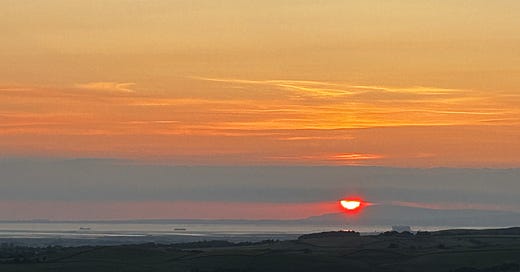It is the autumn equinox and we are striding albeit slowly up the slopes of Black Combe in the Lake District. It’s an extreme outlier in the southwest of the district. Wainwright described the grass bridleway to its summit from Whicham “amongst the most delectable of Lakeland fell paths”
We have seen watched black combe from afar across Moreham Bay, from our local and daily Beacon Fell walks. We have seen it in all moods and weather, at sunset, dawn, at night under northern lights, in mist, in snow and often not at al.l hidden behind clouds.
Until now, though, we haven’t walked here, despite many ‘we must do it’ conversations. And now conferences and workshops in the area provided the opportunity and here we are. It is breezy, sun rays are moving across the Bay and the North Sea shimmering light, and sea mist makes it hard to tell the horizon line—all fast and loose watercolour inspiration.
Closer, the bloom of purple heather has now faded into its autumn hue. A few meadow pipets rise from the bracken and a few ravens free-wheel in the wind.
We sat at the top of Black Combe early afternoon. There at the time of the exact equinox gave an extra dimension to Place. A sense of where the earth’s rotation is at the point of equal day and night. The 360° views are extensive, or would be with less haze, north where the haze gives distant views of the central fells a magical floating impression, south into the bay and west over the North Sea to where the Isle of Man was hiding.
the amplest range
Of unobstructed prospect may be seen
That British ground commands.
In depth, in height, in circuit, how serene
The spectacle, how pure!—Of Nature’s works,
In earth, and air, and earth-embracing sea,
A revelation infinite it seems;
Wordsworth “View from the top of Black Comb”From the top, the beautiful, easy walking northwards gave that wonderful lofty and airy mindful walking. The sun was warm, verging on hot, and the breeze now gentle. Our walking conversations typically range from domestic stuff to more academic discussions, politics, finding common ground, and exploring ideas. Yet our walking has that wonderful silent companion space. Walking that gives mindful time and space for reflection to enable thoughts to come and go with the rhythm of the walking pace.
Here on Black Combe, it was space to allow me to shape upcoming talks and events, the keynote on kinship for SEDA, nature positive session on Future Leadership for IFLP, biophilia for London Build Expo and workshops in Romania, possibles in Kosovo and Albania and more.
And to reflect ...
On Soil, Soul, and Society and the words of Satish Kumar in that most of the current environment movement is driven by fear of doom and disaster, and that cannot be the right motivation for a truly regenerative future.
On Ayana Elizabeth Johnson’s new book ‘What if We Get it Right’ and the serendipity of her Climate Action Venn Diagram, (What are you good at? What work needs doing? What brings you joy?) popping up three times this past week - in a search around her new book, from Britt Wray’s keynote at the My Green Lab conference and in a watercolour conversation with Kaitlyn Gillis following her recommendation to check out Nicole Kelner’s work who has a watercolour adaptation.
On how nature around us in this moment, is just ‘being’, is interdependent, how symbiotic systems coexist and emerge, ebb and flow and how nature would strategise on a three or five-year plan. Yet it probably would not be so arrogant to do so alone or even to set such a short time frame but would embrace the cycle of growth, rest, decay, rebirth and emergence.
On how ecosystems move together, symbiotically as weather patterns, light, the autumn slow decay, the land going into rest, the ash and beach groves, the solitary mountain ash, the birds, the heather and us as humans, although passing through, all players of actors in this ecosystem, experiencing connections, joy and atoms of delight.
On nature as a partner as an ‘interested party’, and how recent ISO amendments now require organisations to identify and consider the climate impact on and from interesting parties. Establishing nature as a partner, as a stakeholder, as an interested party, is something I’ve raised over the years but can I do so more confidently with more organisations listening. And asking., What is it nature asks of us?
On how not including nature in strategy, to consider nature’s role as zero impact is simply not responsible and may not be compliant with legislation.
On how encouraging to witness and hear of organisations now embracing, considering or questioning how nature is integral in what they do. I recall hearing how Chile has a Nature Department that sits above its finance department. How awesome and necessary that could be for organisations, to make financial considerations subservient to nature.
On understanding how the symbiotic flow and emergence of ideas needs time and space for gathering, for group reflections that come from the soul and the heart, not something relegated to digital process or as AI-written cookie-cutter strategies.
Do read on for suggested listing and prompts for ISO interested party climate impacts, that place earth and nature as the key interested party, with key questions to ask for better understanding.




